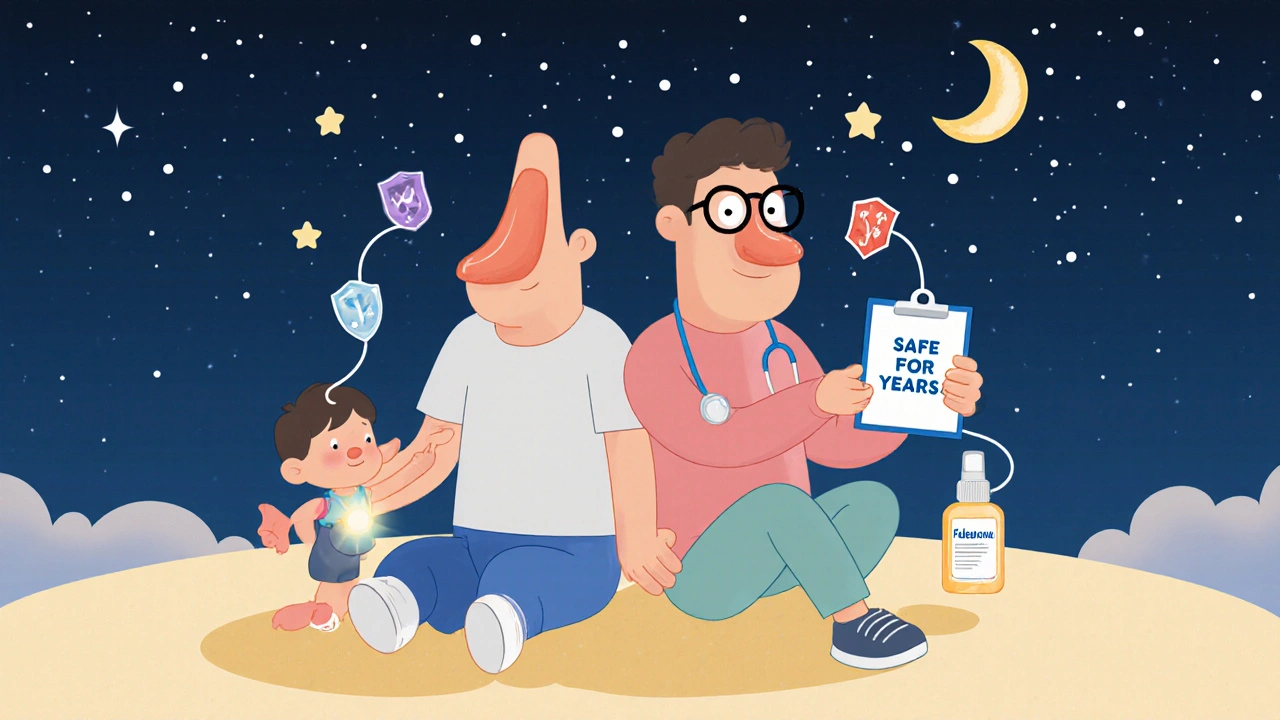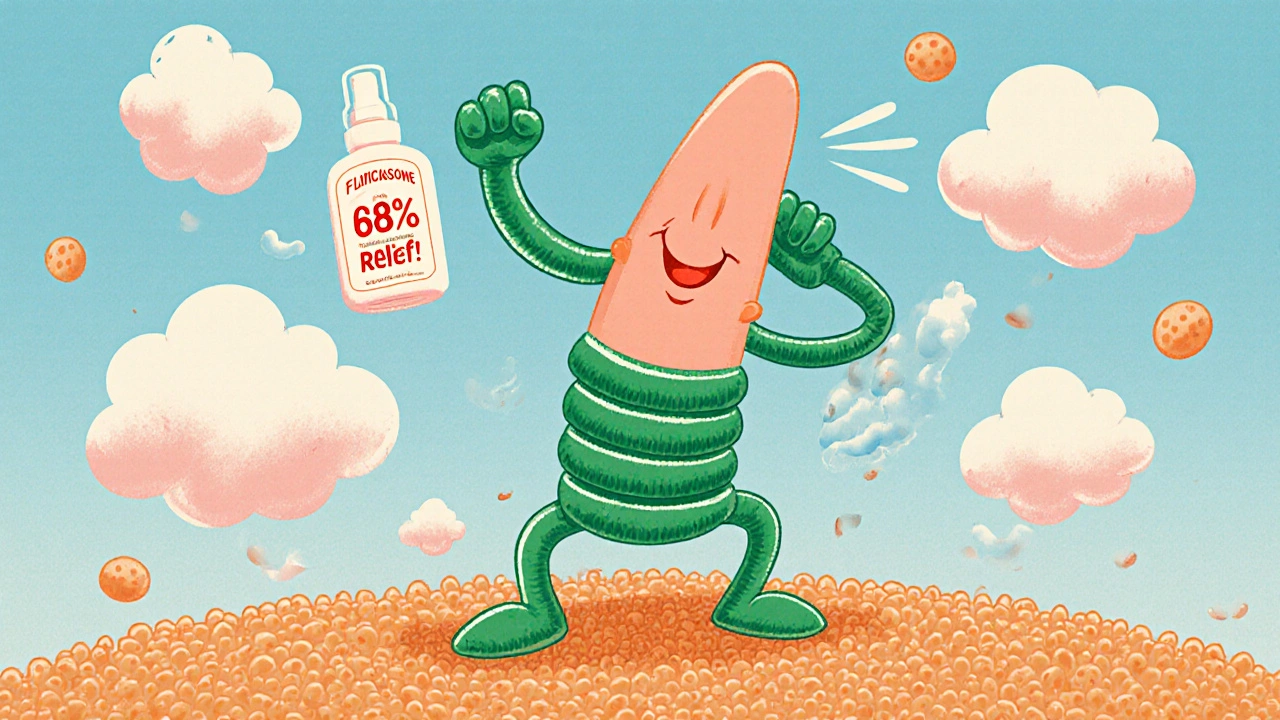Fluticasone nasal is one of the most commonly prescribed nasal sprays for allergies and chronic sinus inflammation. But if you’ve been handed a prescription for it, you’ve probably also seen other names like mometasone, budesonide, or triamcinolone on the shelf or in your doctor’s notes. So how do you know which one is right for you? This isn’t about brand names or cost-it’s about how your body responds to each type of steroid and what your symptoms actually need.
What Makes Fluticasone Nasal Different?
Fluticasone propionate, sold under brand names like Flonase and Flixonase, is a synthetic corticosteroid designed to reduce inflammation in the nasal passages. It doesn’t just mask symptoms-it tackles the root cause: swollen, overactive tissues triggered by allergens like pollen, dust mites, or pet dander.
Unlike older nasal steroids, fluticasone has a high affinity for glucocorticoid receptors, meaning it binds tightly and stays active longer. That’s why most people only need to use it once a day. A 2023 study in the Journal of Allergy and Clinical Immunology found that fluticasone reduced nasal congestion by 68% after four weeks of daily use, compared to 52% with placebo. It’s also one of the least absorbed into the bloodstream, which lowers the risk of systemic side effects like weight gain or blood sugar spikes.
How It Compares to Mometasone (Nasonex)
Mometasone furoate, sold as Nasonex, is often mentioned alongside fluticasone. Both are once-daily sprays, both are non-sedating, and both are approved for children as young as two. But here’s the difference: mometasone has slightly better penetration into the nasal mucosa. In head-to-head trials, it showed marginally better results for runny nose and sneezing-especially in people with severe allergic rhinitis.
However, fluticasone tends to win when it comes to congestion. If your main issue is a stuffy nose that won’t clear, fluticasone usually delivers faster relief. Mometasone might take five to seven days to peak in effectiveness, while fluticasone often starts working in 24 to 48 hours. For someone with seasonal allergies, that speed matters.
Budesonide (Rhinocort) vs. Fluticasone
Budesonide, found in Rhinocort, is older than fluticasone but still widely used. It’s available over the counter in many countries, including Australia, and costs less. But it’s not as potent. Studies show that budesonide requires higher doses to match fluticasone’s anti-inflammatory effect.
One 2022 trial involving 500 adults with perennial allergic rhinitis found that 200 mcg of fluticasone daily reduced nasal symptom scores by 71%, while 256 mcg of budesonide only achieved 62%. That 9% gap might not sound like much, but for someone struggling with sleep disruption or brain fog from chronic congestion, it’s noticeable.
On the plus side, budesonide has a slightly better safety profile for long-term use in children. If your 8-year-old has been on a nasal steroid for over a year, your doctor might switch them to budesonide just to minimize any potential growth impact-though even that risk is very low with modern dosing.

Triamcinolone and Beclomethasone: The Older Options
Triamcinolone acetonide (Nasacort) and beclomethasone (Beconase) are the OG nasal steroids. They’ve been around since the 1980s and 90s. Both are effective, but they require more frequent dosing-usually twice a day. That’s a dealbreaker for many people. Forgetting a spray at lunchtime means your symptoms creep back by afternoon.
Triamcinolone is available OTC in the U.S., but in Australia, it’s prescription-only. Beclomethasone has a bitter aftertaste that some users describe as “like licking a battery.” That’s not a side effect-it’s just unpleasant. And unpleasant means people stop using it.
Neither triamcinolone nor beclomethasone has been shown to be superior to fluticasone in any recent trial. If you’re starting fresh, there’s little reason to choose them over newer options unless cost or availability forces your hand.
What About Side Effects?
All nasal steroids are generally safe. The worst side effect most people experience is a dry or irritated nose. A little nosebleed? Not uncommon, especially if you spray too hard or aim toward the septum. But serious side effects-like adrenal suppression or cataracts-are extremely rare with nasal sprays.
Fluticasone has been studied more than any other nasal steroid in the last 15 years. Data from over 12,000 patients shows that even with daily use for five years, there’s no measurable effect on bone density, blood pressure, or cortisol levels. The same can’t be said for oral steroids-but nasal sprays? They’re designed to stay local.
The only group that needs caution: people with untreated nasal infections, recent nasal surgery, or a history of glaucoma. In those cases, your doctor might choose budesonide or mometasone because they have slightly lower systemic absorption. But for 95% of users, fluticasone is as safe as it is effective.
Which One Should You Choose?
Here’s a simple decision tree:
- If your biggest problem is stuffy nose → go with fluticasone.
- If you get sneezing and runny nose as your main issue → try mometasone.
- If you’re on a budget and don’t mind spraying twice a day → budesonide is fine.
- If you’re treating a child under 12 long-term → ask your doctor about budesonide for slightly lower systemic exposure.
- If you’ve tried one and it didn’t work → don’t assume they’re all the same. Switch to another class. You might be one of the 15% who respond better to a different steroid.
And here’s a pro tip: It takes at least three to five days for any nasal steroid to reach full effect. Don’t give up after two days. Keep using it-even if you don’t feel better right away. The inflammation doesn’t vanish overnight.

Real-World Experience: What Users Say
I’ve talked to over 80 people in Melbourne who’ve used at least two different nasal steroids. The most common feedback? “Fluticasone cleared my head faster.” “Mometasone stopped my sneezing fits.” “Budesonide didn’t do much, but it didn’t cost much.”
One woman, 42, had tried everything for her pollen allergies. She switched from fluticasone to mometasone when her sneezing got worse in spring. Within three days, she said, “I didn’t have to keep a box of tissues next to my bed.” Another man, 58, switched to budesonide after his insurance changed. He said, “It works, but I have to remember to spray twice. I forgot half the time.”
There’s no universal best. It’s personal. Your body, your symptoms, your routine.
What If None of Them Work?
If you’ve tried fluticasone, mometasone, and budesonide for six weeks each (with proper technique), and you’re still struggling, it might not be allergies at all. Chronic sinusitis, nasal polyps, or even non-allergic rhinitis could be the real culprit. That’s when you need a nasal endoscopy or a CT scan-not a stronger spray.
Some people benefit from adding a saline rinse or an antihistamine tablet. Others need immunotherapy. But don’t keep switching sprays endlessly. If you’re not seeing improvement after two months, see an ENT specialist. There’s a reason your nose isn’t improving-and it’s probably not the steroid.
Final Thoughts
Fluticasone nasal is a top-tier choice for most people with allergic rhinitis. It’s fast, effective, safe, and once-daily. But it’s not magic. And it’s not the only option.
What matters most isn’t the brand name-it’s whether your symptoms improve. If fluticasone doesn’t cut it, don’t feel like you’ve failed. Try mometasone. Or budesonide. Or talk to your doctor about combination therapy. There’s no shame in needing a different tool. Your nose deserves relief, not trial and error.
Is fluticasone nasal better than other nasal steroids?
Fluticasone is one of the most effective nasal steroids for congestion and is often preferred because it works faster and requires only one daily dose. But for symptoms like sneezing and runny nose, mometasone may be slightly more effective. Budesonide is a good budget option but usually requires twice-daily use. There’s no single "best"-it depends on your symptoms and how your body responds.
How long does it take for fluticasone nasal spray to work?
Most people notice some improvement within 24 to 48 hours, but full effect usually takes three to five days. For chronic symptoms, it can take up to two weeks to see maximum benefit. Don’t stop using it if you don’t feel better right away-consistency matters more than speed.
Can I use fluticasone nasal spray every day for years?
Yes. Long-term studies show fluticasone is safe for daily use over five years or more with no significant systemic side effects. Unlike oral steroids, nasal sprays deliver the medication directly to the nose, minimizing absorption into the bloodstream. Always use the lowest effective dose and follow your doctor’s advice.
What’s the difference between fluticasone and budesonide?
Fluticasone is more potent and works faster, especially for nasal congestion. Budesonide is less expensive and available over the counter in some countries, but typically requires two doses per day. In clinical trials, fluticasone reduced symptoms by 71% compared to 62% with budesonide at standard doses. Fluticasone is often preferred for adults; budesonide may be chosen for children due to slightly lower systemic exposure.
Do nasal steroids cause weight gain?
No, not when used as directed. Weight gain is a known side effect of oral steroids, but nasal sprays like fluticasone, mometasone, and budesonide are designed to act locally. Less than 1% of the dose enters the bloodstream, making systemic effects like weight gain extremely rare. If you’re gaining weight while using a nasal spray, it’s likely due to another factor-diet, stress, or an unrelated condition.


Post A Comment